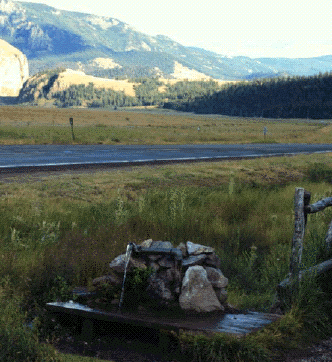
McKinney Gulch Spring at the foot of Snowshoe Mountain

Regolith in the Seven Parks area is formed by disaggregation of bedrock with little chemical or mineralogical modification. Temperature and water conditions in the subsurface are consistent with those required for mechanical disintegration by segregation freezing.
Water modified by short-term infiltration of the regolith in the Seven Parks study area has distinctly different chemical characteristics from waters sampled from wells, which reside in bedrock fractures for longer periods.
Experimental results support our contention that freshly-created rock surfaces in the regolith are responsible for relatively high K+/SiO2 ratios observed in infiltrating waters, probably as a result of early dissolution of interstitial glass.
Chemical weathering in the regolith at Seven Parks is a short-lived, annual event that cannot be described by steady-state, stoichiometric dissolution of silicate minerals.
Akagawa S. and Fukuda M. (1991) Frost heave mechanism in welded tuff. Permafrost and Periglacial Processes, 2, 301-309.
Claassen H.C. and White A.F. (1979) Application of geochemical kinetic data to groundwater systems: A tuffaceous rock system in southern Nevada. In Modeling: Speciation, Sorption, Solubility and Kinetics in Aqueous Systems (ed. E. Jenne), American Chemical Society, (771-793).
Claassen H.C., Reddy M.M., and Halm, D.R. (1986) Use of the chloride ion in determining hydrologic-basin water budgets - a 3 year case study in the San Jaun mountains, Colorado, U.S.A. Journal of Hydrology 85, 49-71.
Curtis, B. (1975) Cenozoic geology of the southern Rocky Mountains. Geological Society of America Memior 144, 279p.
Hallet B., Walder J.S. and Stubbs C.W. (1991) Weathering by segregation ice growth in microcracks at sustained sub-zero temperatures; verification from an experimental study using acoustic emissions. In Cryogenic weathering; proceedings of a workshop on mechanical weathering (ed. K. Hall and J.-P. Lautridou); Permafrost and Periglacial Processes 2, 283-300.
Hoch A. R., Reddy M.M. and Drever J.I. (1996) The effect of iron content and dissolved O2 on dissolution rates of clinopyroxene at pH 5.8 and 25o C: preliminary results. Chemical Geology, 132, p. 151-156.
Stallard R.F. (1995) Tectonic, environmental and human aspects of weathering and erosion: a global review using a steady-state perspective. Annu. Rev. Earth Planet. Sci. 23, 11-39.
Steven T.A. and Lipman P.W. (1976) Calderas of the San Juan volcanic field, southwestern Colorado. U.S. Geological Survey Prof. Pap.958, 35.
Walder J. and Hallet B. (1985) A theoretical model of the fracture of rock during freezing. GSA Bull. 96, 336-346.
 McKinney Gulch Spring at the foot of Snowshoe Mountain |
WORK IN PROGRESS:We are currently investigating processes occurring in fractured bedrock beneath the regolith. These processes include: calcite and silicate mineral dissolution, clay formation, and water movement in the sub-surface. A comprehensive model will then describe the evolution of water chemistry from precipitation at the top of the mountain to stream and spring discharge at the base of the mountain, with implications for the upper Rio Grande River system. |

